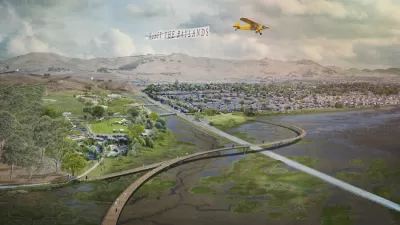In expectation of a new exhibit opening at the Whitney Museum of Art, the New Yorker reflects on the curious life and career of Buckminster Fuller.
"Fuller's schemes often had the hallucinatory quality associated with science fiction (or mental hospitals). It concerned him not in the least that things had always been done a certain way in the past. In addition to flying cars, he imagined mass-produced bathrooms that could be installed like refrigerators; underwater settlements that would be restocked by submarine; and floating communities that, along with all their inhabitants, would hover among the clouds.
Most famously, he dreamed up the geodesic dome. "If you are in a shipwreck and all the boats are gone, a piano top . . . that comes along makes a fortuitous life preserver," Fuller once wrote. "But this is not to say that the best way to design a life preserver is in the form of a piano top. I think that we are clinging to a great many piano tops in accepting yesterday's fortuitous contrivings." Fuller may have spent his life inventing things, but he claimed that he was not particularly interested in inventions. He called himself a "comprehensive, anticipatory design scientist"-a "comprehensivist," for short-and believed that his task was to innovate in such a way as to benefit the greatest number of people using the least amount of resources. "My objective was humanity's comprehensive success in the universe" is how he once put it. "I could have ended up with a pair of flying slippers."
FULL STORY: Dymaxion Man

Planetizen Federal Action Tracker
A weekly monitor of how Trump’s orders and actions are impacting planners and planning in America.

Map: Where Senate Republicans Want to Sell Your Public Lands
For public land advocates, the Senate Republicans’ proposal to sell millions of acres of public land in the West is “the biggest fight of their careers.”

Restaurant Patios Were a Pandemic Win — Why Were They so Hard to Keep?
Social distancing requirements and changes in travel patterns prompted cities to pilot new uses for street and sidewalk space. Then it got complicated.

DC Area County Eliminates Bus Fares
Montgomery County joins a growing trend of making transit free.

Platform Pilsner: Vancouver Transit Agency Releases... a Beer?
TransLink will receive a portion of every sale of the four-pack.

Toronto Weighs Cheaper Transit, Parking Hikes for Major Events
Special event rates would take effect during large festivals, sports games and concerts to ‘discourage driving, manage congestion and free up space for transit.”
Urban Design for Planners 1: Software Tools
This six-course series explores essential urban design concepts using open source software and equips planners with the tools they need to participate fully in the urban design process.
Planning for Universal Design
Learn the tools for implementing Universal Design in planning regulations.
Heyer Gruel & Associates PA
JM Goldson LLC
Custer County Colorado
City of Camden Redevelopment Agency
City of Astoria
Transportation Research & Education Center (TREC) at Portland State University
Camden Redevelopment Agency
City of Claremont
Municipality of Princeton (NJ)




























